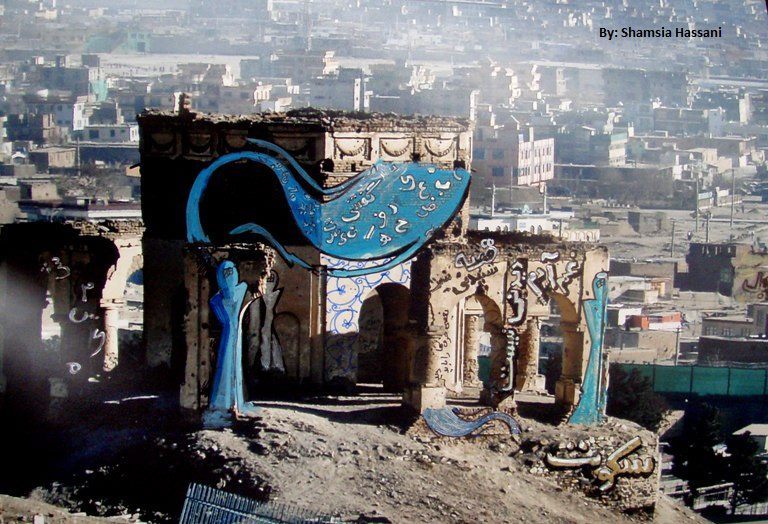Helmand
I want
simple love
empty dreams
uncluttered
hallways in
gutted houses
of the soul
I want
air between
my nightmares
and silence
in my sleep
I want
a truce called
and the
ghost armies
sent home
the dead
buried and
the wounded
cared for
and cleaned
for transport
in silent
helicopters
I want
the battlefield
scraped and
burned
a garden
planted and
water gathered
I want
a place
that’s better
once we
leave.


--Shamsia Hassani (graffiti artist)
Helmand is the largest province in Afghanistan, covering 58,584 sq km (20,000 sq mi). The world's largest opium-producing region, it provides around 80% of production. A frequent target for conquest because of its strategic location, which connects Southern, Central and Southwest Asia, some Vedic scholars identify the Helmand valley as the Sarasvati area ("rich in waters/lakes") mentioned in the "Rig Veda" as the homeland of the Indo-Aryan migration into India (ca. 1500 BCE). It was mentioned in the "Avesta"(the primary collection of Zoroastrian religious texts) as Haetumant, one of the early Zoroastrian centers, but it was called "White India" due to the large numbers of Hindus and Buddhists who lived there. Governed by the Medes and then the Achaemenids, it was invaded in 330 BCE by Alexander the Great and then became part of the Seleucid Empire. Later, the area was part of Arachosia, the general geographical term for the land between Central Asia and the Indus river; its capital, Alexandropolis, was in modern Kandahar. Before the Saffarids of Zaranj established Muslim rule, it was part of Zabulistan, ruled by the sun-worshipping Zunbils. In the 10th century it fell to the Ghaznavids and then to the Ghurids. After the Mongol destructions in the 13th century, it was ruled by the Timurids. Babur, the first Mughal emperor, took it in the early 16th century. However, the area was often contested by the Safavids, until Mir Wais Hotak defeated them in 1709 and established the Hotaki dynasty, who ruled until 1738, when they were defeated by the Afsharids. In 1747, it submitted to Ahmad Shah Durrani and has been part of Afghanistan ever since. In 1880 the British helped Abdur Rahman Khan restore Afghan rule over warring tribes. But then the area stayed calm until the 1979 Soviet invasion. In the 1960s it was known as "Little America" due to a USAID development program.
ReplyDeleteIn 2001, in response to the September 11 attacks on the US by al-Quaeda, an Anglo-American bombing campaign supported ground forces supplied primarily by the Afghan Northern Alliance but supplemented by NATO troops began a war to remove the Taliban regime. In 2006, a revitalised Taliban conducted a number of large-scale military offensives against coalition troops in Helmand, Kandahar, and other provinces on the border with Pakistan, briefly taking Baghran district. A combined NATO-Afghan mission targeted Taliban fighters in southern Afghanistan, but the powerful provincial governor demanded the protection of areas that were under immediate threat. This led to a "platoon house" strategy that tied down mainly British troops in remote outposts across northern Helmand. They all attracted sustained and intensive Taliban attacks and remained under siege for long periods, especially at Sangin, Musa Qala, and Kajaki. Commanders on the ground described the situation as the most brutal conflict the British army had been involved in since the Korean War. In the fall, both sides began reaching "cessation of hostilities" agreements and mutual withdrawal from the combat zone. By the end of the year a de facto border was established east of Garmsir along the Helmand river. In the spring, American forces took Garmsir, after the Taliban had withdrawn; other American troops reinforced Sangin, Gereshk, Musa Qaleh, and Now Zad, as well as districts in Farah province, and launched operations to disrupt Taliban activities between Gereshk and Sangin and to strengthen the Afghan government’s control of the Musa Qaleh Wadi. At the beginning of June the Taliban launched a new offensive in Kandahar, Farah, and Helmand. In August they began operating closer to Halmand's capital, Lashkar Gah, taking Marja and Nad Ali, just 10 km from the city. In October the Taliban launched two direct attack on Lashkar Gah, their most ambitious operation since 2006, but they were repulsed by Afghan troops. A new offensive began in June 2009, leading to the UK's bloodiest week in the war, but officials declared the operation to be a success. In 2010, 15,000 American, Afghan, and British soldiers (the largest joint operation so far) aimed to remove the Taliban from Marjah, the last Taliban stronghold in central Helmand. Afghan and NATO officials assembled a large team of administrators and 1,900 police, but the Afghans failed to set up a working government in the town, leading to a temporary resurgence by the Taliban. And the war continued.
ReplyDeletePhenomenal!!
ReplyDeleteI very much like this gentleman's poems. Bravo.
ReplyDeletethank you all very much.
ReplyDelete